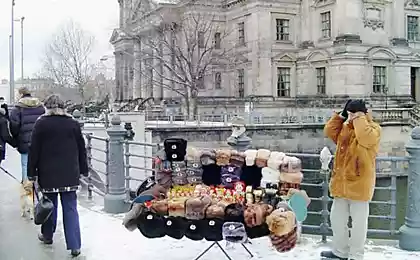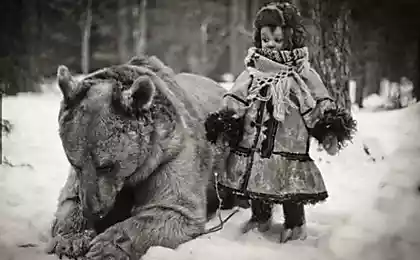793
Russian forgery.
Fakes, we lost
At the end of XIX century in Russia for the Society for Consumer Protection would be a lot of work. Sorry, this company has ever had. In pre-revolutionary Russia sophisticated way tampered with any food, they are adding unexpected ingredients like road dust, arsenic, lime, clay or mercury.
Society for the Protection of Consumer Rights before the revolution was not. Dead man (or happened, the whole family) from poisoning - families have nowhere to complain. Nor was so perfect expertise to pinpoint the source of intoxication. With swindlers struggled letter of the law. And after scandals or publications. In 1890 a law was passed, which equates to the "preparation for sale and sale of the" possession of counterfeit goods in commercial and industrial premises. Accordingly intensified and punishment: a fine of up to 300 rubles, or arrest for up to 3 months. This, however, did not stop those who implemented the defective product. The history of fraud in Russia - it is also a story of corruption.
Which product is most often forged, he is mentioned in the law. Bread, meat (1845), butter, fats (1891). Then chronologically followed bee honey, coffee, milk, flour, beer, saccharin, tea, milk substitutes and other female. Supervision of the quality of the products carried by individual laboratories and physicians enthusiasts and check-raids were carried out sporadically, when the complaint came from privileged persons.
So, once the official Ministry of Finance (!) Obliged to ensure that under the guise of butter not margarine sold. Someone tired of the pillars of potatoes, flavored with rancid fat, and he ordered prizhuchit scoundrels-forgers. A special laboratory in Moscow made test purchases and margarine found in more than half of all the samples of oil. It was then that the "top" and thoughtful: how is it that the margarine, which was originally created as though not full, but still nutritious replace more expensive animal fat, he became a victim of manufacturers surrogates?
According to one official forces whether the army was overcome tsehovikov- "margarinschikov"? Especially since the factory producing margarine (or rather, a cruel parody of it), nobody believed. As a result, a dairy store, which sold exclusively in animal products, is strictly forbidden to trade in margarine, and manufacturers - to paint it in the colors of oil.
But from the sale of margarine disappeared. Any institution could be called kefir creamery, but actually produced a yellow substance, sold under the guise of vintage "Paris", "Petersburg" or "chuhonskogo" oil. Before buying oil, incredulous hostess took the first small slice and put on warm potato. Check resembled a wine tasting. If swallowed, butter left a pleasant aftertaste in your mouth, and margarine - a nasty taste. Bozhbe seller or the clerk did not believe. Already very high risk that even a small fraction of the "product" could cause severe gastrointestinal upset - greedy breeders presence of harmful bacteria in margarine did not care.
No luck and olive (Provencal) butter. In Russia it is, of course, imported - from Greece, France and Italy. But the product in its pure form to stand on the counter was unprofitable. The price for a "bite", and buy olive oil for special occasions, preferring cheap sunflower. Sharpness sellers know the recipe of falsification. They took lean, sesame, linseed and olive oils, mixed them in a certain proportion to fight off the smell of sunflower seeds, and - voila! - The output is a "crystal clear" olive. This operation, in which the number of units was calculated as accurately as the ratio of water and alcohol at the Mendeleev craftsmen achieved the ideal, as we would say today, the ratio "price - quality". At least, claims it is for olive oil were relatively few.
Higher chic is fake product so that "supplements" do not impair its nutritional properties and does not bring harm to the body, such as milk, which is often diluted in water with lime divorced, knowing that most of his other children drink. And the opposite example of "caring about the quality" - eggs in the generous time rather expensive delicacy. Being soaked in beer (preferably homemade), it significantly adds to the weight and volume. The taste and other characteristics of the delicacy is totally reflected. And catch the Dodgers was virtually impossible. But such experiments often amused attendants in restaurants than in food stores.
The latter is not too wisely. So, having learned that the buyer like that lump sugar has noble slightly bluish (not white or yellowish, which is natural) color, vendors have begun to infiltrate Sugarloaf weak solution of methylene blue or aniline dye. Slightly typing in the title already not cheap sweetness was a great success. More greedy mixed with sugar crystals (will not say which), which were dissolved in a glass of tea and poorly precipitated. Sex in restaurants, even those collected nuggets - for re-sale through the grocers.
Coffee and tea in the heyday of the Russian Empire, too, had no luck. It would seem that not naduesh inveterate coffee lover, but did you go - even though the abundance of shops "colonial" products, natural kofy with all its expensive purchase was difficult. Many varieties of available for sale, and even ground coffee beans was a blatant forgery.
Basically fake coffee were making abroad, and in Russia there were agents who shove it in the shops. But the police found out that, it turns out, in the two capitals have highly secret craftsmen specializing in coffee. The results of police raids stunned: the whole cooperative vagrants in appalling unhygienic conditions (eg, in the basement of the rooming house Khitrovskaya the last analysis) molded grain "coffee" manually from wheat, barley, beans or corn dough, fried in molasses.
Sometimes falsification differed much more shamelessly. In 1880 in St. Petersburg it took several trials. Falsifiers sent to hard labor, is made from corn ... tinted clay, plaster and putty! "Dealer" is, of course, demonstrated the mediators real coffee beans, and the goods brought fake. In the bean smell is weak, but the scammers specifically soaked in brewed coffee bags to package the aroma was truly fascinating to fell for merchants.
With ground coffee technology was different. It was diluted with chicory, barley and other cereals (technology relevant today). Sometimes crooks were not lazy to go to areas known only to them, to collect the dust there, perfectly matching the color and the "caliber" to grind grain. Carefully sifted and mixed with this product, dust the same way precipitated. All hush-hush.
When the report on all sorts of tricks thieves lay on the table superiors in the police department of Moscow, it was ordered to check the grocers: what actually sell these "sons of bitches"? It turned out a report not be deceived in the ground coffee for sale contains from 30 to 70 percent of impurities. Absolutely pure product could not be found ...
Less wealthy class were immune from trouble after drinking fake coffee. They are used not his, but much more the people's drink - tea. We note in passing that the "national" tea was relative. Outside the boundaries of big cities to live whole villages, whose inhabitants have never in my life have not tried the tea! I wonder if they used samovars, and if so, for what purpose?
But in the city of tea - this is the "Our Father": without it began morning. Is it any wonder that the falsification of tea reached striking dimensions. On admixture of the lower to the higher grades and say nothing: it was a matter of the ordinary. A more creative "processing" shared leadership, both Russian capitals, each of which has given the informal name of the variety and the most common counterfeit tea "Rogozhsky" and "Koporye." First fabricated from sleeping tea in Moscow, Rogozhskaya part, the second - in one of the parishes of St. Petersburg province. Sleeps tea, as well as food additives are not to sugar, collected by institutions, tinted sugar color, Prussian blue, indigo, turmeric, salt, and iron and copper paint "betel". For a taste of grass mixed into willow-herb, the leaves of roses, strawberries, poplar and fireweed. Come true through the back door to the restaurants, pubs and even in the restaurants, but the one that went to the stores, packaged, podsypaya to increase the weight of sand, clay and even lead dust. Knowing about these wisdoms vendors, shopkeepers, however, against unauthorized intrusions and did not object to the blue eye vtyuhivali hellish mix gullible buyers.
About tea as the object of falsification spoke more often. Since tea was introduced a special tax, rightly demand the state to tighten control over the implementation. But whether all hands did not reach, or scale control was immense - the tea was still neglected and disfigured.
What tea - forged saccharin itself sweetener. Saccharin is several times cheaper than natural sugar, and 500-600 times sweeter. But he was not everyone can afford. Therefore, there were hitrovany who asked the question: with such a high concentration of sweetness distinguish whether the buyer of the pill of saccharin diluted by ten times? Hardly. And they successfully bodyazhit saccharin ...
But back to the drinks. One of the first places in scale rigging in pre-revolutionary Russia is the grape wine. Not too popular if the people (as, incidentally, and beer), alcoholic beverage could not compete with the excellent quality of the vodka-producing state monopoly and guaranteed. But he had his own customer.
Wine mainly regularly drank where made: in the wine-growing areas. The considerable number of its transported in both the capital and in major cities, where "sufficient classes" on wine has been a steady demand. Especially popular were the Crimean wines. Some varieties, the assurances of experts, to the best foreign - French and Spanish.
And, nevertheless, fake began already in production. The manufacturers are increasingly interfering in the process spent centuries - of course, to the detriment of the consumer. In the late XIX-early XX century natural wine has become a rarity. The analyzes, produced in the Crimea and Bessarabia, the Caucasus and the Don, have shown that many "wine" are made from water, sugar and alcohol and do not contain a single drop of grape juice. Moreover, they found extremely harmful to the body chemicals.
The control of the production of wine - as the forces and capabilities - intensified, and winemakers have been forced to increase the production of quality products. But the fakes from this have not diminished. Enthusiast Dr. Gulishambarov published sensational calculations. It appeared from 1887 to 1890 Moscow received from the wine regions of 460 thousand. Pounds of wine each year, but at the same time meet the needs of half million population, exported to other regions up to 800 thousand. Pounds! But the International Winery in Moscow there was no ...
Counterfeits blow to the few fans of beer. In areas where brewing is a traditional fishing claims to drink was not. But in Moscow and St. Petersburg in taking bottle samples found even poisonous additives. More often to affordable beers, already burdened fusel oil, mixed into wormwood, strychnine, aloe, bleached or picric acid. It was probably then that the famous saying about the curvature of nonrandom excretory functions of the body.
"All the best - to children." Even if Lenin did not say that, you probably thought. Because Vova Ulyanov, the future leader of the world proletariat, parents are encouraged for a good study in the gymnasium candy (sweets as they used to say). Most it turned out to be harmful. Because "if sweets prepared from nutrients and did not contain any harmful impurities, they could bring significant benefits, even the children," - plunged the community into shock contemporary, young Ilich MD Anna Fisher Dyukelman. And resolutely unmask konfektnyh manufacturers: "But the color of these products is almost always artificial, often toxic paints. Such, for example, the green paint from Verdigris, and French greenery shveynfurtskoy containing arsenic; red - from cinnabar and red lead; White - of lead and zinc oxide; blue - mineral and royal blue; yellow - the lead glёta, orpiment, gummigutta, picric acid, and so on. d. ».
Ilyich, when matured, probably remembered what it was etched in my childhood, and gave the factory, including confectionery, work. And for many years, our country has produced the world's best chocolates. Without the letter "K" in the middle, but from natural ingredients.
You read in the press about the pre-revolutionary countless cases of food poisoning, and you catch yourself thinking: how do people survive somehow, if the law does not protects people from criminals-food industry ?! After all, even if only to sit on bread and canned food, the risk of seriously undermining its own body remained huge. Although, if only because not all ran into a model for some bread bakery Filippova and buy loaves and loaves in the shops in the neighborhood. A lovchily baker would try to buy cheap meal, that is spoiled. Bread from it does not happen uniformly porous, it is heavier and darker. To hide the flour was added to the copper sulfate, alum, lime water and other stuff like the same road dust, only light. And in order to enhance the lifting test was mixed into soda and hydrochloric acid and then sodium phosphate. Sometimes the bread found deadly salt of arsenic and mercury.
Popular among the people pasta often trumps of poor quality flour, and instead of the eggs were added to her saffron. Well, fats and even relying on technology a cheap salt in pasta and spent the night.
It was not so good with canned food: the production process is often violated, hygiene rules were not respected, so more or less serious cases of poisoning were recorded with frightening regularity. However, as death. One high-profile criminal cases were instituted after the poisoning canned green peas people in different cities. The examination found that to give peas a natural green tinted his poisonous copper sulphate.
Another high-profile trial was held on traders vinegar, very popular at the time seasoning. To give him a big castle, dealers mixed into a solution of hydrochloric or sulfuric acid. Roughly also allegedly produced natural sauces, syrups and fruit concentrates. Dyes, sweeteners - all as it is today. Only many times more harmful to the body.
It turns out that without regard for God and conscience dealers falsified and successfully marketed almost everything? Unsurprisingly, then, pick up the baton of porters Russian-leftists China found in our country, the grateful customers: genes, you know ...

Source:
At the end of XIX century in Russia for the Society for Consumer Protection would be a lot of work. Sorry, this company has ever had. In pre-revolutionary Russia sophisticated way tampered with any food, they are adding unexpected ingredients like road dust, arsenic, lime, clay or mercury.
Society for the Protection of Consumer Rights before the revolution was not. Dead man (or happened, the whole family) from poisoning - families have nowhere to complain. Nor was so perfect expertise to pinpoint the source of intoxication. With swindlers struggled letter of the law. And after scandals or publications. In 1890 a law was passed, which equates to the "preparation for sale and sale of the" possession of counterfeit goods in commercial and industrial premises. Accordingly intensified and punishment: a fine of up to 300 rubles, or arrest for up to 3 months. This, however, did not stop those who implemented the defective product. The history of fraud in Russia - it is also a story of corruption.
Which product is most often forged, he is mentioned in the law. Bread, meat (1845), butter, fats (1891). Then chronologically followed bee honey, coffee, milk, flour, beer, saccharin, tea, milk substitutes and other female. Supervision of the quality of the products carried by individual laboratories and physicians enthusiasts and check-raids were carried out sporadically, when the complaint came from privileged persons.
So, once the official Ministry of Finance (!) Obliged to ensure that under the guise of butter not margarine sold. Someone tired of the pillars of potatoes, flavored with rancid fat, and he ordered prizhuchit scoundrels-forgers. A special laboratory in Moscow made test purchases and margarine found in more than half of all the samples of oil. It was then that the "top" and thoughtful: how is it that the margarine, which was originally created as though not full, but still nutritious replace more expensive animal fat, he became a victim of manufacturers surrogates?
According to one official forces whether the army was overcome tsehovikov- "margarinschikov"? Especially since the factory producing margarine (or rather, a cruel parody of it), nobody believed. As a result, a dairy store, which sold exclusively in animal products, is strictly forbidden to trade in margarine, and manufacturers - to paint it in the colors of oil.
But from the sale of margarine disappeared. Any institution could be called kefir creamery, but actually produced a yellow substance, sold under the guise of vintage "Paris", "Petersburg" or "chuhonskogo" oil. Before buying oil, incredulous hostess took the first small slice and put on warm potato. Check resembled a wine tasting. If swallowed, butter left a pleasant aftertaste in your mouth, and margarine - a nasty taste. Bozhbe seller or the clerk did not believe. Already very high risk that even a small fraction of the "product" could cause severe gastrointestinal upset - greedy breeders presence of harmful bacteria in margarine did not care.
No luck and olive (Provencal) butter. In Russia it is, of course, imported - from Greece, France and Italy. But the product in its pure form to stand on the counter was unprofitable. The price for a "bite", and buy olive oil for special occasions, preferring cheap sunflower. Sharpness sellers know the recipe of falsification. They took lean, sesame, linseed and olive oils, mixed them in a certain proportion to fight off the smell of sunflower seeds, and - voila! - The output is a "crystal clear" olive. This operation, in which the number of units was calculated as accurately as the ratio of water and alcohol at the Mendeleev craftsmen achieved the ideal, as we would say today, the ratio "price - quality". At least, claims it is for olive oil were relatively few.
Higher chic is fake product so that "supplements" do not impair its nutritional properties and does not bring harm to the body, such as milk, which is often diluted in water with lime divorced, knowing that most of his other children drink. And the opposite example of "caring about the quality" - eggs in the generous time rather expensive delicacy. Being soaked in beer (preferably homemade), it significantly adds to the weight and volume. The taste and other characteristics of the delicacy is totally reflected. And catch the Dodgers was virtually impossible. But such experiments often amused attendants in restaurants than in food stores.
The latter is not too wisely. So, having learned that the buyer like that lump sugar has noble slightly bluish (not white or yellowish, which is natural) color, vendors have begun to infiltrate Sugarloaf weak solution of methylene blue or aniline dye. Slightly typing in the title already not cheap sweetness was a great success. More greedy mixed with sugar crystals (will not say which), which were dissolved in a glass of tea and poorly precipitated. Sex in restaurants, even those collected nuggets - for re-sale through the grocers.
Coffee and tea in the heyday of the Russian Empire, too, had no luck. It would seem that not naduesh inveterate coffee lover, but did you go - even though the abundance of shops "colonial" products, natural kofy with all its expensive purchase was difficult. Many varieties of available for sale, and even ground coffee beans was a blatant forgery.
Basically fake coffee were making abroad, and in Russia there were agents who shove it in the shops. But the police found out that, it turns out, in the two capitals have highly secret craftsmen specializing in coffee. The results of police raids stunned: the whole cooperative vagrants in appalling unhygienic conditions (eg, in the basement of the rooming house Khitrovskaya the last analysis) molded grain "coffee" manually from wheat, barley, beans or corn dough, fried in molasses.
Sometimes falsification differed much more shamelessly. In 1880 in St. Petersburg it took several trials. Falsifiers sent to hard labor, is made from corn ... tinted clay, plaster and putty! "Dealer" is, of course, demonstrated the mediators real coffee beans, and the goods brought fake. In the bean smell is weak, but the scammers specifically soaked in brewed coffee bags to package the aroma was truly fascinating to fell for merchants.
With ground coffee technology was different. It was diluted with chicory, barley and other cereals (technology relevant today). Sometimes crooks were not lazy to go to areas known only to them, to collect the dust there, perfectly matching the color and the "caliber" to grind grain. Carefully sifted and mixed with this product, dust the same way precipitated. All hush-hush.
When the report on all sorts of tricks thieves lay on the table superiors in the police department of Moscow, it was ordered to check the grocers: what actually sell these "sons of bitches"? It turned out a report not be deceived in the ground coffee for sale contains from 30 to 70 percent of impurities. Absolutely pure product could not be found ...
Less wealthy class were immune from trouble after drinking fake coffee. They are used not his, but much more the people's drink - tea. We note in passing that the "national" tea was relative. Outside the boundaries of big cities to live whole villages, whose inhabitants have never in my life have not tried the tea! I wonder if they used samovars, and if so, for what purpose?
But in the city of tea - this is the "Our Father": without it began morning. Is it any wonder that the falsification of tea reached striking dimensions. On admixture of the lower to the higher grades and say nothing: it was a matter of the ordinary. A more creative "processing" shared leadership, both Russian capitals, each of which has given the informal name of the variety and the most common counterfeit tea "Rogozhsky" and "Koporye." First fabricated from sleeping tea in Moscow, Rogozhskaya part, the second - in one of the parishes of St. Petersburg province. Sleeps tea, as well as food additives are not to sugar, collected by institutions, tinted sugar color, Prussian blue, indigo, turmeric, salt, and iron and copper paint "betel". For a taste of grass mixed into willow-herb, the leaves of roses, strawberries, poplar and fireweed. Come true through the back door to the restaurants, pubs and even in the restaurants, but the one that went to the stores, packaged, podsypaya to increase the weight of sand, clay and even lead dust. Knowing about these wisdoms vendors, shopkeepers, however, against unauthorized intrusions and did not object to the blue eye vtyuhivali hellish mix gullible buyers.
About tea as the object of falsification spoke more often. Since tea was introduced a special tax, rightly demand the state to tighten control over the implementation. But whether all hands did not reach, or scale control was immense - the tea was still neglected and disfigured.
What tea - forged saccharin itself sweetener. Saccharin is several times cheaper than natural sugar, and 500-600 times sweeter. But he was not everyone can afford. Therefore, there were hitrovany who asked the question: with such a high concentration of sweetness distinguish whether the buyer of the pill of saccharin diluted by ten times? Hardly. And they successfully bodyazhit saccharin ...
But back to the drinks. One of the first places in scale rigging in pre-revolutionary Russia is the grape wine. Not too popular if the people (as, incidentally, and beer), alcoholic beverage could not compete with the excellent quality of the vodka-producing state monopoly and guaranteed. But he had his own customer.
Wine mainly regularly drank where made: in the wine-growing areas. The considerable number of its transported in both the capital and in major cities, where "sufficient classes" on wine has been a steady demand. Especially popular were the Crimean wines. Some varieties, the assurances of experts, to the best foreign - French and Spanish.
And, nevertheless, fake began already in production. The manufacturers are increasingly interfering in the process spent centuries - of course, to the detriment of the consumer. In the late XIX-early XX century natural wine has become a rarity. The analyzes, produced in the Crimea and Bessarabia, the Caucasus and the Don, have shown that many "wine" are made from water, sugar and alcohol and do not contain a single drop of grape juice. Moreover, they found extremely harmful to the body chemicals.
The control of the production of wine - as the forces and capabilities - intensified, and winemakers have been forced to increase the production of quality products. But the fakes from this have not diminished. Enthusiast Dr. Gulishambarov published sensational calculations. It appeared from 1887 to 1890 Moscow received from the wine regions of 460 thousand. Pounds of wine each year, but at the same time meet the needs of half million population, exported to other regions up to 800 thousand. Pounds! But the International Winery in Moscow there was no ...
Counterfeits blow to the few fans of beer. In areas where brewing is a traditional fishing claims to drink was not. But in Moscow and St. Petersburg in taking bottle samples found even poisonous additives. More often to affordable beers, already burdened fusel oil, mixed into wormwood, strychnine, aloe, bleached or picric acid. It was probably then that the famous saying about the curvature of nonrandom excretory functions of the body.
"All the best - to children." Even if Lenin did not say that, you probably thought. Because Vova Ulyanov, the future leader of the world proletariat, parents are encouraged for a good study in the gymnasium candy (sweets as they used to say). Most it turned out to be harmful. Because "if sweets prepared from nutrients and did not contain any harmful impurities, they could bring significant benefits, even the children," - plunged the community into shock contemporary, young Ilich MD Anna Fisher Dyukelman. And resolutely unmask konfektnyh manufacturers: "But the color of these products is almost always artificial, often toxic paints. Such, for example, the green paint from Verdigris, and French greenery shveynfurtskoy containing arsenic; red - from cinnabar and red lead; White - of lead and zinc oxide; blue - mineral and royal blue; yellow - the lead glёta, orpiment, gummigutta, picric acid, and so on. d. ».
Ilyich, when matured, probably remembered what it was etched in my childhood, and gave the factory, including confectionery, work. And for many years, our country has produced the world's best chocolates. Without the letter "K" in the middle, but from natural ingredients.
You read in the press about the pre-revolutionary countless cases of food poisoning, and you catch yourself thinking: how do people survive somehow, if the law does not protects people from criminals-food industry ?! After all, even if only to sit on bread and canned food, the risk of seriously undermining its own body remained huge. Although, if only because not all ran into a model for some bread bakery Filippova and buy loaves and loaves in the shops in the neighborhood. A lovchily baker would try to buy cheap meal, that is spoiled. Bread from it does not happen uniformly porous, it is heavier and darker. To hide the flour was added to the copper sulfate, alum, lime water and other stuff like the same road dust, only light. And in order to enhance the lifting test was mixed into soda and hydrochloric acid and then sodium phosphate. Sometimes the bread found deadly salt of arsenic and mercury.
Popular among the people pasta often trumps of poor quality flour, and instead of the eggs were added to her saffron. Well, fats and even relying on technology a cheap salt in pasta and spent the night.
It was not so good with canned food: the production process is often violated, hygiene rules were not respected, so more or less serious cases of poisoning were recorded with frightening regularity. However, as death. One high-profile criminal cases were instituted after the poisoning canned green peas people in different cities. The examination found that to give peas a natural green tinted his poisonous copper sulphate.
Another high-profile trial was held on traders vinegar, very popular at the time seasoning. To give him a big castle, dealers mixed into a solution of hydrochloric or sulfuric acid. Roughly also allegedly produced natural sauces, syrups and fruit concentrates. Dyes, sweeteners - all as it is today. Only many times more harmful to the body.
It turns out that without regard for God and conscience dealers falsified and successfully marketed almost everything? Unsurprisingly, then, pick up the baton of porters Russian-leftists China found in our country, the grateful customers: genes, you know ...

Source:
























